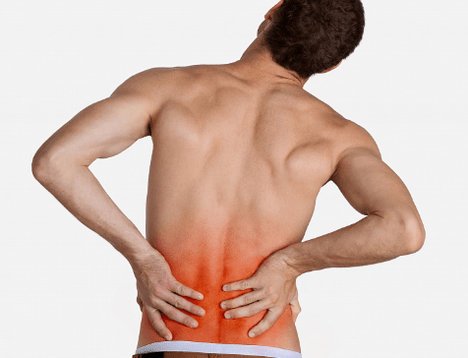Lumbar osteohondrose is the deformation of the spine in the lumbar area.The disease affects intervertebral discs, cartilage tissues, spinal roots and nerve fiber and causes back pain.
Reasons

The main cause of the disease is an improper distribution of cargo on the musculos-bone system.Usually this happens when walking in high heels, carrying a bag on one side, with an unpleasant image or sitting work.At risk, older people, pregnant, only born, professional athletes and office workers.
Other causes of lumbar osteochondrose:
- injuries, bruises, weapon breakals, legs, spine;
- damage to the body of the muscle-bone system;
- Gastrointestinal diseases causing the lack of useful substances;
- Body tension for longer loads;
- Psychoemotic disorders;
- Violations of blood flow in the spinal column;
- Inflammation of the musculoskeletal apparatus;
- Infections of the internal organs and vertebrae;
- Joint stiffness, disk movement;
- protrusion and intervertebral hernia;
- strong intoxication;
- Metabolic disorders;
- Keeps curvature;
- Sedentary lifestyle;
- dehydration;
- Unbalanced diet;
- Lack of calcium and oxygen;
- Excess weight;
- bad habits;
- Age-relefined changes;
- Joint diseases.
Symptoms of lumbar osteochondrose
The intensity and nature of the symptoms depend on the disease phase.The faster patient finds signs of lurbosacral osteochondrose, which will be a treatment more efficient.
General symptoms:
- Strong pain at the bottom of the back that can give legs, inner abdominal bodies and pelvis;
- kidney pain and hid;
- fatigue and stress in the lower back and the sacral part of the spine;
- difficulties in motion, walking, inclinations and body turns;
- Periodic background back;
- Fatigue after a minor cargo;
- Rear crumbly, mobility violation, pain in a quiet state;
- stiffness of limbs;
- Spasms and muscle cramps;
- dizziness;
- Weakness and loss of strength;
- Reduction of muscle tone and sensitivity.
In men and women, lumbar osteochondrose events can vary.Men can have problems with potent.Women often suffer from pile in pelvis.When the deformed spine cannot fully support the rear, uterus and accessories experience additional loads, and sometimes move into a normal physiological position.
Varieties
The classification of osteochondrose of the lumbar spine consists of several varieties of the disease.According to the type of pain syndrome, they differ:
Lumbago.An acute symptom.He expresses him sharp bastards and the inability to move.He occurs with muscular cramps, injuries, pinching discs and nerve roots.
Lumbar.It is characterized by long-term pain of pain caused by hernia, bumps, spondylarilia, ligaments and other musculos-bone system disorders.
Sciatica.Powerful syndrome in the lumbosakral department, eradies in the basin.Pain refers to the nerve's nerve, prevents normal bending and extension of the body, prevents me from sitting and not standing painless.
Discogenic lumbar osteochondrosis and radicalopathy also differ.
Diskogena lumbar osteochondroseIt is accompanied by loss of sensitivity and stiffness not only on the painful back, but also with legs, buttocks, hips and bottom of the abdomen.Sometimes the temperature, weakness, urinary incontinence, the patient loses weight.
Radiculopathypronounced stiffs of nerve roots and reducing human motor skills.Signs - tingles or pain in the entire lower body, impaired reflexes, reduction of muscle tone and joints of the limbs.
Stages of Lumbar Osteochondroze
Doctors search for dynamics of pathology in four phases:
- First.The symptoms are almost invisible - are diagnosed in X -Ray.The stadium begins with pathological processes in the purpose of the preserved disk cavity and the microcracks of the fibrous ring.
- Second.The height of the interverters is reduced, which makes the vertebra closely located.This causes sliding and moving vertebrae, which are accompanied by pain during the movement.
- Third.It is characterized by numbness, instability, body stiffness in coccyx, lower back and hid.This can be explained by protruding vertebrates, childbirth, joint dislocutism and arthrosis in the spine.
- Fourth.The hardest degree.The functions of the spinal column are reduced on it and bone growth (osteophytes) are formed.Grow can score nerves or damage the integrity of vertebrae.
Consequences of osteochondrose lumbar
- Excessive body salt accumulation;
- Development of Hernia, protrusion, prolapiers of vertebral and disks;
- chronic radiculitis;
- Parez and paralysis of the legs.
Diagnostics
Lumbar osteochondrose and other musculoskelo system disorders can diagnose orthopedic, osteopaths, neurologists, rheumatologists, manual therapists and surgeons.It is possible to make a precise diagnosis after:
- X -Raj spinal column, which shows the condition of bones, cartilage and muscle tissues, as well as ligaments and tendons.
- Myelography - Studies of cerebrospinal fluid with colors.With his help, the nerve roots of the spinal cord are studied and evaluated.
For more detailed examination, doctors use CT and MRI.You can undergo diagnostics in the clinic.

























